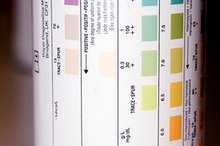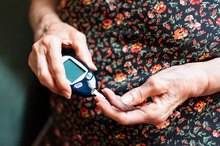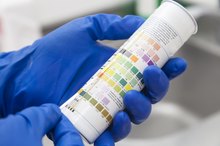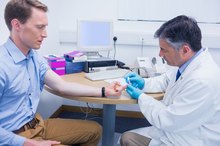What does fact checked mean?
At Healthfully, we strive to deliver objective content that is accurate and up-to-date. Our team periodically reviews articles in order to ensure content quality. The sources cited below consist of evidence from peer-reviewed journals, prominent medical organizations, academic associations, and government data.
The information contained on this site is for informational purposes only, and should not be used as a substitute for the advice of a professional health care provider. Please check with the appropriate physician regarding health questions and concerns. Although we strive to deliver accurate and up-to-date information, no guarantee to that effect is made.
What Is Plus 4 in Glucose Levels?
Physicians measure glucose, a carbohydrate used by your body for energy generation, in the urine. Any value above plus zero glucose in the urine can indicate abnormality and may be a red flag for a serious medical condition -- diabetes mellitus 1. Diabetes can cause serious damage to your circulation, leading to multiple-organ-system compromise over time. Doctors treat diabetes with dietary changes, exercise and medications.
What is Glucose?
Glucose fuels your body and brain. Most of the carbohydrates you consume as part of your daily diet converts to glucose via a set of biochemical reactions that begin in your mouth, continue in your intestines and finish after the ingested carbohydrates have been transported into your blood stream.
How is Glucose Measured?
Color of Urine Strips for Ketosis
Learn More
Depending on the reason you are having your glucose measured, your doctor may want a glucose measurement from your blood, from your urine or from your cerebrospinal fluid. As well, depending on the type of test you're going to have, you may be requested to fast for at least 8 hours prior to the test. Urine glucose measurements are typically reported in positive-integer increments, and a typical urine glucose measurement is plus zero, since your kidney typically does not excrete any glucose into your urine 1. A plus four urine glucose reading would indicate that you have an extremely high concentration of glucose in your urine and would mandate further evaluation for diabetes and possibly diabetic ketoacidosis 1.
Diseases with High Urine Glucose
In the vast majority of cases, high urine glucose known as "glycosuria," results from hyperglycemia occurring with diabetes mellitus. However, there are some genetic disorders that result in glycosuria. For example, Fanconi's syndrome, a genetic disorder that causes the kidney to poorly reabsorb several substances, results in glycosuria 4. Glycosuria can occur during pregnancy, with most women experiencing a return to normal urine glucose levels after giving birth.
- In the vast majority of cases, high urine glucose known as "glycosuria," results from hyperglycemia occurring with diabetes mellitus.
- Glycosuria can occur during pregnancy, with most women experiencing a return to normal urine glucose levels after giving birth.
Health Consequences of High Glucose
How to Interpret Dipstick Urinalysis Results
Learn More
Atypically high blood glucose, also known as diabetes mellitus, leads to pathologic changes in your circulatory system that can cause:
- serious damage to your heart
- kidneys
- nerves
- eyes
This occurs because the excess glucose in your blood attaches itself to proteins found in these organs, irreversibly altering their function.
Treatment
If you have significant glycosuria as the result of diabetes, your doctor may ask you to try lifestyle modifications to bring down your blood glucose. These include eating a healthier diet and exercising regularly. If these measures fail to adequately lower your blood glucose, your doctor may prescribe medications such as metformin or insulin, designed to lower blood glucose.
Related Articles
References
- Medline Plus: Glucose test (urine)
- "Harrison's Principles of Internal Medicine"; Anthony S. Fauci, Eugene Braunwald, Dennis L. Kasper, Stephen L. Hauser, Dan L. Longo, J. Larry Jameson, Joseph Loscalzo; 2008
- Greenspan's Basic and Clinical Endocrinology; David Gardner and Dolores Shoback; 2006
- Medline Plus: Fanconi Syndrome
- National Institute of Diabetes and Digestive and Kidney Diseases. Diabetes diet, eating, & physical activity. Published December 2016.
- American Diabetes Association. The big picture: Checking your blood glucose.
- American Diabetes Association. 6. Glycemic Targets: Standards of Medical Care in Diabetes-2020. Diabetes Care. 2020;43(Suppl 1):S66-S76. doi:10.2337/dc20-S006
- American Diabetes Association. 14. Management of diabetes in pregnancy: Standards of medical care in diabetes-2020. Diabetes Care. 2020;43(Suppl 1):S183-S192. doi:10.2337/dc20-S014
- Porcellati F, Lucidi P, Bolli GB, Fanelli CG. Thirty years of research on the dawn phenomenon: Lessons to optimize blood glucose control in diabetes. Diabetes Care. 2013;36(12):3860-2. doi:10.2337/dc13-2088
- American Diabetes Association. 5. Lifestyle management: Standards of medical care in diabetes-2019. Diabetes Care. 2019;42(Suppl 1):S46-60. doi:10.2337/dc19-S005
- Colberg SR, Sigal RJ, Yardley JE, et al. Physical activity/exercise and diabetes: A position statement of the American diabetes association. Diabetes Care. 2016;39(11):2065-2079. doi:10.2337/dc16-1728
- American Diabetes Association (ADA). Understanding A1C.
- Garber AJ, Abrahamson MJ, Barzilay JI, et al. Consensus statement by the American association of clinical endocrinologists and American college of endocrinology on the comprehensive type 2 diabetes management algorithm - 2019 executive summary. Endocr Pract. 2019;25(1):69-100. doi:10.4158/CS-2018-0535
Resources
Writer Bio
Alex Folkl has been writing for more than eight years and has had work appear in several peer-reviewed and non-peer-reviewed scientific publications. He has a bachelor's degree in biology, a master's degree in pathobiology, and an MD.









